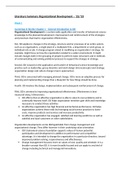Samenvatting
Summary Articles Organization Development - Master SHOP UU
- Instelling
- Universiteit Utrecht (UU)
Summary of all the article for the course 'Organization Development: Monitoring and Changing'. The summary is written in English.
[Meer zien]




